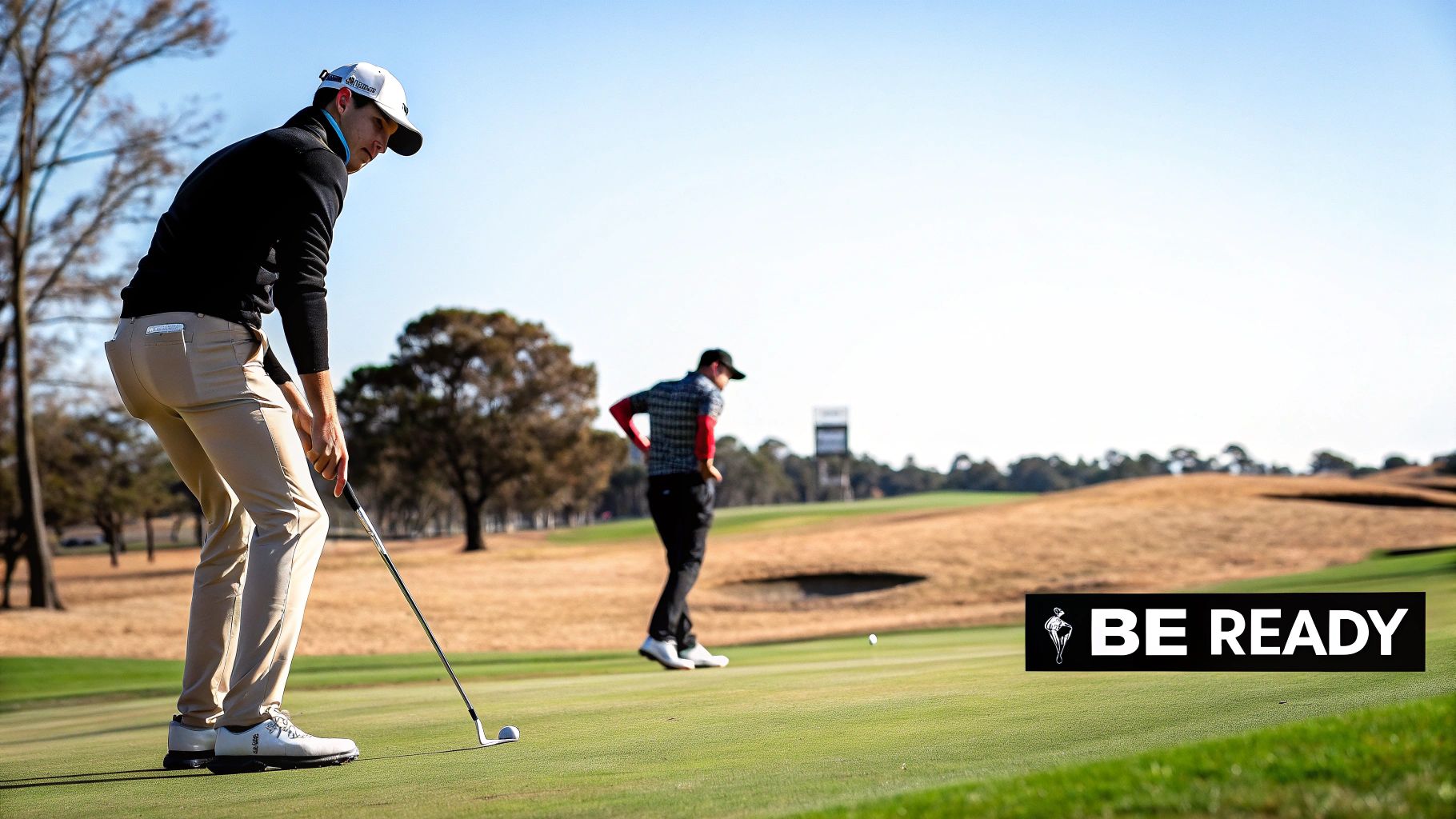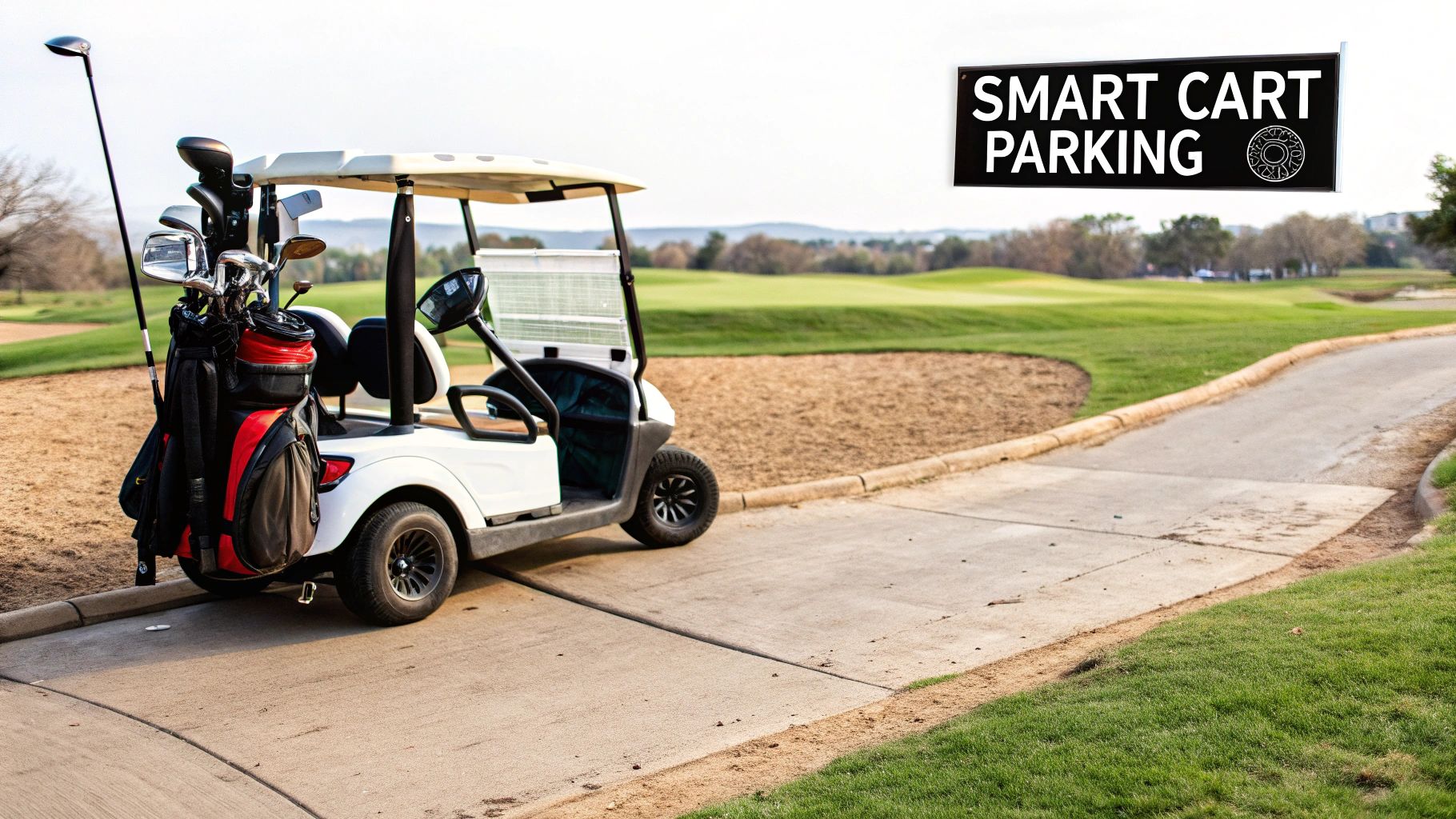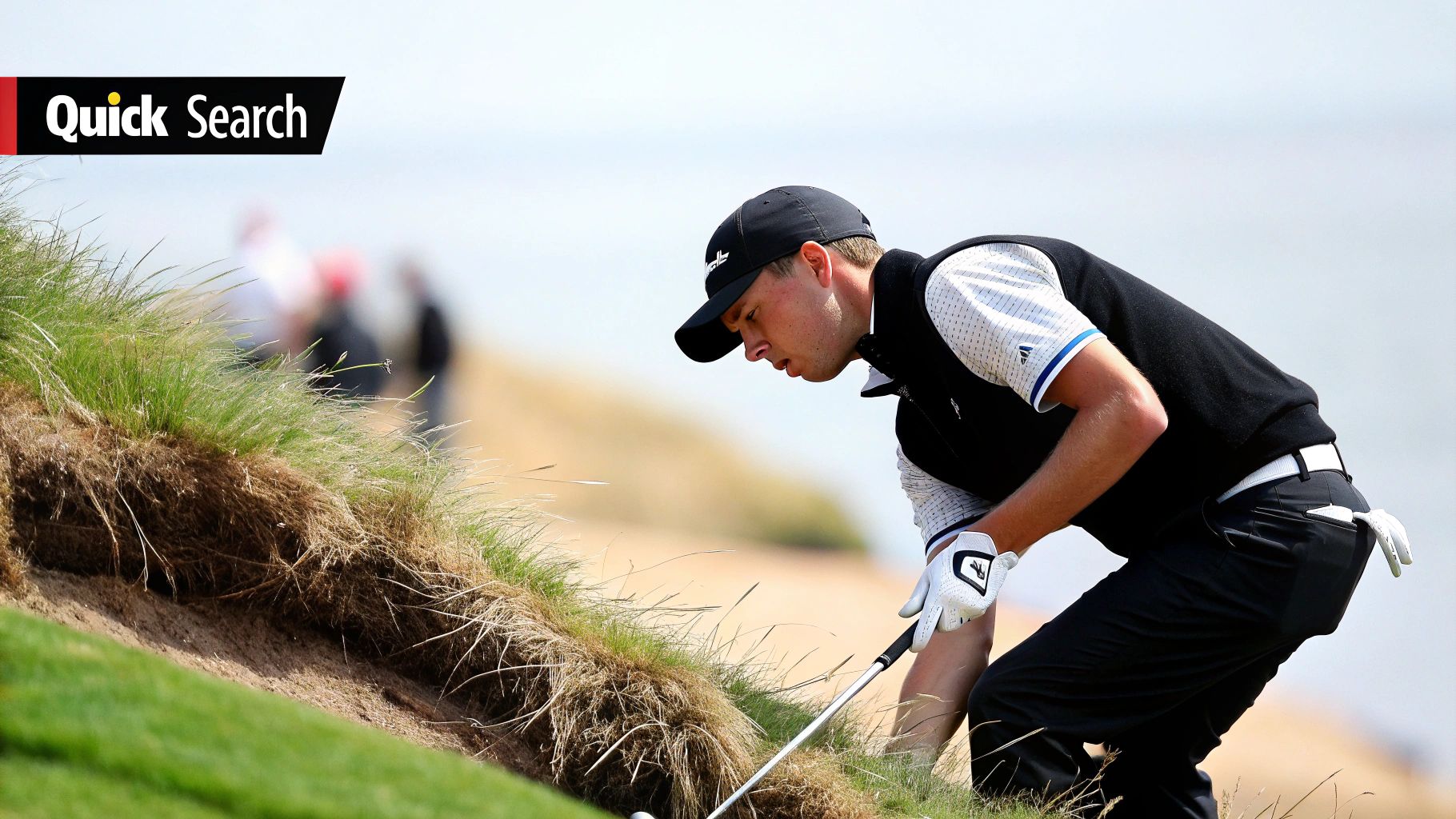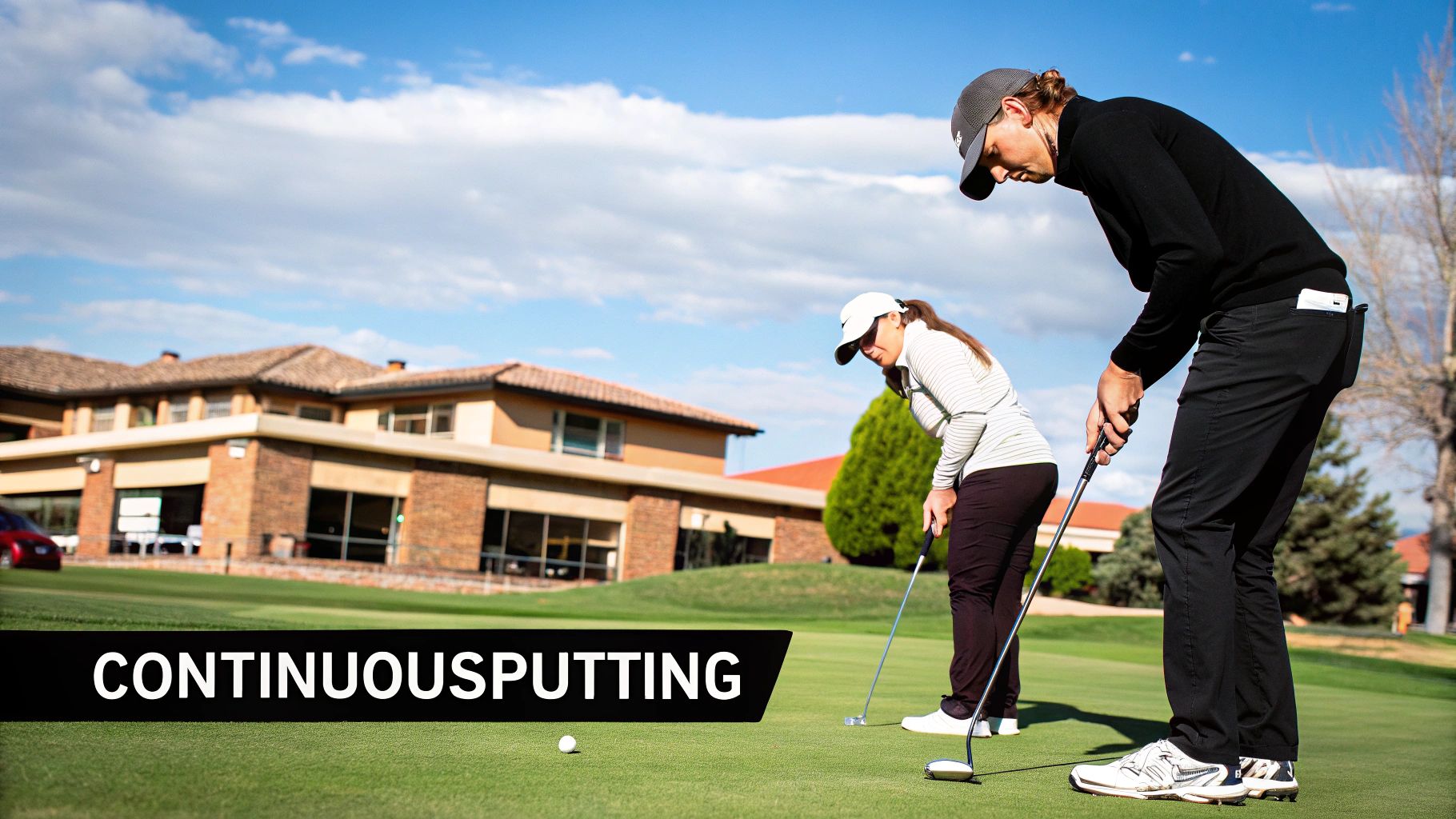Slow play is one of the most persistent frustrations in golf, turning a potentially joyous four hours into a five-hour-plus marathon of waiting. It affects everyone, from the group grinding to a halt behind you to your own rhythm and enjoyment. But improving pace isn't just about rushing; it's about playing smarter and more efficiently.
The good news is that with a few conscious adjustments, your foursome can become a model of efficiency, ensuring every round is played at a brisk, enjoyable pace. These aren't just generic suggestions; they are actionable strategies that address the root causes of slow play, from pre-shot routines to on-course logistics. We'll explore six powerful golf pace of play tips that will not only speed up your game but also enhance your focus and overall experience on the course.
We’ll also touch on how modern equipment can help you conserve energy and stay ahead of the clock. For walking golfers, using an electric push cart assistant like the Caddie Wheel can make the walk as effortless as the decision to play faster, helping you get to your ball and prepare for your next shot without delay. By mastering these techniques, you'll contribute to a better on-course environment for everyone.
1. Be Ready When It's Your Turn
The cornerstone of all golf pace of play tips is remarkably simple yet profoundly impactful: be prepared to hit your shot the moment it is your turn. This proactive mindset, often called "ready golf," is the single most effective way to shave minutes off your round and keep the group behind you happy. It involves thinking ahead and performing your pre-shot tasks while others are playing, ensuring you can step up and execute without unnecessary hesitation.

The concept is simple: instead of waiting idly for your turn, use the time your partners are hitting to prepare. This approach doesn't mean rushing your shot; it means rushing to be ready for your shot.
How to Implement "Ready Golf"
Being ready is a habit built on a few key actions. By integrating these into your on-course behavior, you can transform your personal pace and contribute to a faster, more enjoyable round for everyone.
- Walk Ahead (Safely): As soon as another player addresses their ball, begin walking to your own. This simple act can save 30-60 seconds per shot. Stay out of their line of sight and remain still while they swing.
- Pre-Shot Preparation: Use the time while walking or waiting to get your yardage with a rangefinder, analyze the wind, and consider your club selection.
- Carry Multiple Clubs: If you're between clubs, bring both to your ball. This eliminates the time-consuming walk back to your bag if you misjudged the distance. A remote-controlled electric caddy like the Caddie Wheel is especially useful here, as you can send it ahead to the next tee or have it follow you, keeping all your clubs within arm's reach.
Key Insight: The goal isn't to hit faster, but to prepare faster. A well-prepared golfer can take a deliberate, focused 30-second pre-shot routine without holding anyone up because they eliminated the two minutes of dead time that came before it.
This proactive approach is championed by organizations like the USGA and PGA Tour, who have launched campaigns to improve the sport's pace. The principle is that the cumulative effect of these small time-saving actions is massive, potentially trimming 2-3 minutes per hole, which adds up to over 30 minutes per round.
2. Play 'Ready Golf' Instead of Strict Honor System
While the first tip focused on being personally ready, this one expands that principle to the entire group. "Ready golf" is a playing philosophy that prioritizes efficiency over the rigid tradition of "honors," where the player with the lowest score on the previous hole tees off first. In ready golf, the first player in the group who is prepared and can play safely does so, keeping the game in constant motion.

This approach is one of the most effective golf pace of play tips because it eliminates the awkward pauses while waiting for the "correct" player to hit. It's now the standard recommendation for recreational play by major golf bodies and has been widely adopted at municipal courses and corporate outings to ensure everyone finishes on time.
How to Implement Ready Golf
Successfully using ready golf requires clear communication and a shared commitment to a faster round. It’s not about rushing; it’s about playing intelligently and efficiently as a group.
- Communicate First: Before the first tee, agree with your playing partners that you'll be playing ready golf. A simple, "Hey guys, mind if we play ready golf today to keep things moving?" is all it takes.
- Prioritize Safety: The golden rule of ready golf is to never hit if another player is in range or could be distracted by your shot. The goal is to be efficient, not dangerous.
- Tee Off When Ready: After everyone arrives at the tee box, the first person ready to hit should go. There's no need to wait for the player who had the birdie on the last hole if they are still grabbing a drink or cleaning their club.
- Putt Out When Close: On the green, if you have a short "tap-in" putt, it's often faster to finish the hole rather than marking your ball and waiting for others to putt from farther away. This is one of the key golf pace of play guidelines that keeps the green clear.
Key Insight: Ready golf is a mindset shift from "Whose turn is it?" to "Can I safely play now?" By adopting this approach, a group can eliminate multiple minutes of dead time on every single hole without anyone feeling rushed during their actual swing.
The National Golf Foundation and Golf Course Superintendents Association of America champion this method. They recognize that the strict honor system, while a cherished tradition in formal competition, is a significant bottleneck during casual rounds. Embracing ready golf is a modern, practical solution to a faster and more enjoyable experience for everyone on the course.
3. Efficient Cart Management and Positioning
Beyond your individual readiness, how you manage your golf cart is a crucial, often overlooked, factor in maintaining a brisk pace. Strategic cart positioning and movement can eliminate minutes of wasted time per hole. It's about treating the cart not just as transportation, but as a strategic tool to streamline the flow of your group from tee to green, minimizing backtracking and unnecessary delays.

This discipline transforms the cart from a simple convenience into a powerful pace-of-play asset. It requires forward thinking: always consider where the cart needs to be not just for the current shot, but for the next one as well. This mindset is a hallmark of experienced players and a key component of excellent on-course etiquette.
How to Implement Smart Cart Strategy
Effective cart management is a simple skill that pays huge dividends in time saved. By adopting these habits, you can significantly speed up your round without ever rushing a swing.
- Park Strategically: The golden rule is to park your cart on the path adjacent to or slightly ahead of the first ball, and ideally pointed toward the next tee box. This prevents you from having to backtrack after holing out.
- Drop and Go: If you are sharing a cart, drive to the first player's ball and let them out with a few potential clubs. The driver can then proceed to their own ball. This parallel processing cuts playtime in half.
- Take Multiple Clubs: When your ball is a significant distance from the cart path, always take your rangefinder, a towel, and at least two or three potential clubs with you. A second trip to the cart can easily waste two minutes.
- Respect Cart Path Rules: Adhering to "Cart Path Only" rules is essential for course maintenance. However, you can still be efficient by dropping your partner off and proceeding to a point on the path nearest your own ball, allowing both players to walk to their shots simultaneously.
Key Insight: Treat your golf cart like a shuttle, not a taxi. Its purpose is to move players and equipment to the most efficient forward position for the next action, not just the current one. This prevents the all-too-common logjam around the green.
Of course, for golfers who prefer to walk, managing equipment efficiently is just as important. For those who want the benefits of walking without the strain of carrying or pushing a heavy bag, exploring the 5 benefits of electric push carts for golfers can reveal how technology like the Caddie Wheel enhances both pace and enjoyment.
4. Limit Ball Searching to 3 Minutes Maximum
One of the most significant pace-of-play killers is the prolonged, often fruitless, search for a lost ball. The official Rules of Golf, modernized by the USGA and R&A, formally reduced the search time from five minutes to three. Adhering strictly to this three-minute limit is a critical component of maintaining momentum and showing courtesy to other players on the course. It’s a rule that benefits everyone, preventing a single errant shot from creating a bottleneck for every group behind you.

This isn't just a suggestion; it's a fundamental rule designed to speed up play. Embracing this limit means accepting the occasional lost ball as part of the game and prioritizing the overall flow of the round over the search for one piece of equipment.
How to Implement the 3-Minute Rule
Effectively managing search time requires discipline and a proactive strategy. The key is to make your search efficient and to always have a backup plan in place before you even begin looking.
- Always Hit a Provisional Ball: If there is any doubt that your ball might be lost or out of bounds, announce and play a provisional ball. This is the single most important habit for preventing delays. If you find your first ball, simply pick up the provisional. If you don't, you can continue play without the time-wasting walk of shame back to the tee.
- Search Systematically as a Group: Don't just wander aimlessly. Have your playing partners help, starting from the point where the ball was last seen and walking in a coordinated pattern. Having your Caddie Wheel wait in a central location keeps bags out of the search area and allows for an easy transition once the search concludes.
- Use a Timer: Actively start a timer on your watch or phone as soon as you begin searching. This removes any ambiguity and forces a decision when the time is up. Let your group know, "Okay, we have three minutes to find this."
Key Insight: The purpose of the three-minute rule isn't to penalize you; it's to protect the pace of play for the entire golf course. Acknowledging when a ball is lost and moving on quickly is a sign of an experienced and considerate golfer.
This practice is rigorously enforced in professional tournaments and by course marshals at busy clubs for a reason. Adopting it in your own game is one of the most impactful golf pace of play tips you can follow, directly contributing to a faster and more enjoyable experience for all.
5. Continuous Putting: Don't Mark Every Ball
The green is often where significant time is lost, with a cycle of marking, cleaning, lining up, and waiting. One of the most effective golf pace of play tips is to adopt "continuous putting," a practice that streamlines activity on the green without sacrificing etiquette. This common-sense approach involves putting out after your initial putt, provided your ball is close to the hole and you are not in another player's line.
Instead of automatically marking your ball regardless of its position, assess the situation. If you have a short tap-in, holing out immediately saves the time it takes for you to mark, step away, wait for others, and then repeat your own pre-putt routine. This simple adjustment keeps the game flowing, especially in casual or corporate rounds where speed is appreciated.
How to Implement Continuous Putting
Incorporating continuous putting requires situational awareness and clear communication with your playing partners. It's about being efficient, not disrespectful of the game or your group.
- Establish the "Tap-In" Rule: Before the round, agree with your group on a general distance for continuous putting, often anything within 2-3 feet. This avoids any confusion and sets a clear expectation.
- Assess Your Position: Always check to ensure you are not standing in or casting a shadow over anyone's putting line. If you are clear, proceed to finish the hole. If not, mark your ball as usual.
- Be Ready to Putt Out: After your first putt, walk to your ball and quickly assess if you can putt out. If so, do it without delay. This proactive mindset is key to saving those precious seconds that add up over 18 holes.
- Handle the Flagstick Efficiently: Be ready to either tend the pin for others or pull it and place it off the green once the first player is on. The player who holes out first should be responsible for grabbing the flag and preparing to place it back in the hole after the last player putts out.
Key Insight: Continuous putting is not about rushing; it's about reducing unnecessary steps. The time saved by one player holing out a two-foot putt is minimal, but when four players do it on every hole, the cumulative effect can trim 15-20 minutes from the round.
This practice is widely encouraged by golf course management and pace-of-play advocates as a simple, no-cost way to improve the experience for everyone. It maintains the integrity of the game while eliminating the dead time spent on the repetitive ritual of marking short putts.
6. Keep Up with the Group Ahead, Not Away from Behind
One of the most common misconceptions about pace of play is that as long as the group behind isn't waiting on you, you're playing fast enough. This is a flawed perspective. The true golden rule for on-course flow is to maintain your position relative to the group in front of you. This mindset shift is a crucial component of good golf etiquette and one of the most effective golf pace of play tips for preventing course-wide traffic jams.
This principle ensures that a single slow group doesn't create a domino effect, backing up every subsequent foursome. By focusing on the group ahead, you are holding your designated spot on the course, which is the standard upheld by course marshals, tournament officials, and private clubs. The goal is to keep the entire course moving like a well-oiled machine.
How to Implement This "Forward-Thinking" Pace
Maintaining your position requires situational awareness and a commitment to your place in the overall flow of play. It’s not about rushing, but about being mindful of the gap between your group and the one you're following.
- Tee Box Check-In: The simplest rule of thumb is this: your group should be on the tee box of a hole as the group ahead is leaving the green. If you arrive at a par-3 and the group ahead is already on the next tee, you've fallen behind.
- Identify Opportunities to Catch Up: If you notice a gap opening up, don't wait for it to widen. Use simpler holes, like a short par-4 or a straightforward par-3, to make up time. A few players hitting quickly or walking briskly can close a 5-minute gap in just a hole or two. Walking the course, especially with an aid like an electric caddy, makes it much easier to adjust your walking speed to close these gaps.
- Let Faster Groups Through: If you have an open hole ahead of you but the group behind is consistently waiting, it is proper etiquette to let them play through. Find a safe spot to pull over and signal them to hit up. This single act can improve the experience for dozens of golfers behind you.
Key Insight: Your primary responsibility is to the group in front, not the one behind. Keeping up prevents you from becoming the source of a slowdown. The group behind you is irrelevant if there's a full hole open in front of you.
This approach is fundamental to organized golf events. In tournament play, pace is monitored by officials who track the interval between groups, not just whether a group is being pushed from behind. Adopting this professional standard in your casual rounds elevates the experience for everyone on the course. For more information on how walking helps you stay connected to the game's rhythm, explore the benefits of walking the golf course.
Golf Pace of Play Tips Comparison
| Item Title | Implementation Complexity 🔄 | Resource Requirements ⚡ | Expected Outcomes 📊 | Ideal Use Cases 💡 | Key Advantages ⭐ |
|---|---|---|---|---|---|
| Be Ready When It's Your Turn | Moderate - Requires multitasking and focus | Low - Mostly mental preparation | Saves 30-45 min per round, maintains flow | Professional tournaments, pace-of-play enforced rounds | Reduces waiting time, improves shot focus |
| Play 'Ready Golf' Instead of Strict Honor System | Moderate - Needs group communication and buy-in | Low - No extra equipment | Significantly reduces delays, keeps momentum | Casual rounds, municipal courses, corporate outings | Flexible hitting order, reduces pressure on slow players |
| Efficient Cart Management and Positioning | Moderate to High - Requires planning and coordination | Medium - Golf cart access required | Faster transitions, reduces walking time | Resort and private clubs, courses with cart paths | Minimizes backtracking, improves round efficiency |
| Limit Ball Searching to 3 Minutes Maximum | Moderate - Requires discipline and coordination | Low - Timer/watch recommended | Prevents course backups, keeps group moving | Competitive play, courses with marshals enforcing limits | Reduces frustration, enforces time management |
| Continuous Putting: Don't Mark Every Ball | Low to Moderate - Needs judgment on green etiquette | Low - No extra resources | Saves 1-2 minutes per green, keeps rhythm | Casual, practice, and corporate rounds | Reduces unnecessary marking, maintains momentum |
| Keep Up with the Group Ahead, Not Away from Behind | Moderate - Requires constant awareness and adjustment | Low - Mental focus needed | Prevents course-wide delays, maintains flow | Tournament play, monitored courses, private clubs | Provides objective pace benchmark, reduces pressure |
Make Faster Play Your New Standard
Mastering the art of efficient golf isn't about rushing your swing or sacrificing your pre-shot routine. Instead, it's about eliminating the unproductive, wasted time that accumulates between shots. By embracing the golf pace of play tips detailed in this guide, you’re not just speeding up your round; you are fundamentally enhancing the experience for yourself and everyone else on the course. The journey to becoming a pace-of-play leader is built on a foundation of awareness, preparation, and proactive decision-making.
Recapping our key strategies, we see a clear path forward. Being ready to hit when it's your turn, adopting the 'ready golf' mindset over strict honors, and positioning your cart strategically are all simple yet powerful habits. These actions minimize downtime and create a continuous, forward-moving rhythm. When you combine these with disciplined ball searches (a firm three-minute maximum) and continuous putting, you'll be amazed at how much time you save without ever feeling hurried. The ultimate goal is to keep up with the group in front, which naturally ensures you're never holding up the group behind.
The True Impact of Efficient Play
Improving your pace of play is a tangible skill that offers significant benefits. A faster round means more time for your family, work, or even another nine holes. It reduces on-course frustration, which can directly lead to better focus and lower scores. When the game flows smoothly, you stay in your rhythm, both mentally and physically. This is especially true for walking golfers, where physical fatigue can be a major factor in slowing down the back nine.
Consider how these tips work together:
- Preparation meets action: By having your club selected and your yardage known before it's your turn, you step up to the ball ready to perform.
- Efficiency becomes instinct: Parking your cart in a direct line to the next tee becomes second nature, shaving minutes off every hole.
- Energy is conserved for what matters: You spend your physical and mental energy planning and executing shots, not searching for balls or pushing a heavy cart up a hill.
This conscious effort transforms you from a passive participant into an active contributor to the course's overall health and enjoyment. You become an ambassador for a better game, setting a positive example for your playing partners. Don't view these as restrictive rules; see them as empowering strategies that put you in control of your time and elevate your entire golfing experience. Start by implementing just one or two of these golf pace of play tips in your next round and build from there. You will quickly discover that faster play is simply better golf.
Ready to make walking the course effortless and keep your pace of play on point? The Caddie Wheel transforms your existing push cart into a powerful, remote-controlled electric caddie, conserving your energy for the perfect shot. Visit Caddie Wheel to see how you can upgrade your game and become a pace-of-play champion.


Share:
Your Guide to Golf Cart Battery Life
Is Walking Golf Good Exercise? Benefits and Insights